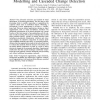Free Online Productivity Tools
i2Speak
i2Symbol
i2OCR
iTex2Img
iWeb2Print
iWeb2Shot
i2Type
iPdf2Split
iPdf2Merge
i2Bopomofo
i2Arabic
i2Style
i2Image
i2PDF
iLatex2Rtf
Sci2ools
JMM2
2007
2007
Object Segmentation Using Background Modelling and Cascaded Change Detection
— The automatic extraction and analysis of visual information is becoming generalised. The first step in this processing chain is usually separating or segmenting the captured visual scene in individual objects. Obtaining a perceptually correct segmentation is however a cumbersome task. Moreover, typical applications relying on object segmentation, such as visual surveillance, introduce two additional requirements: (1) it should represent only a small fraction of the total amount of processing time and (2) realtime overall processing. We propose a technique that tackles these problems using a cascade of change detection tests, including noise-induced, illumination variation and structural changes. An objective comparison of common pixelwise modelling methods is first done. A cost-based partitiondistance between segmentation masks is introduced and used to evaluate the methods. Both the mixture of Gaussians and the kernel density estimation are used as a base to detect structural ch...
Related Content
| Added | 15 Dec 2010 |
| Updated | 15 Dec 2010 |
| Type | Journal |
| Year | 2007 |
| Where | JMM2 |
| Authors | Luís Filipe Teixeira, Jaime S. Cardoso, Luís Corte-Real |
Comments (0)

